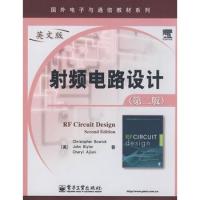| 定價: | ¥ 45 | ||
| 作者: | (美)鮑威克 等著 | ||
| 出版: | 電子工業出版社 | ||
| 書號: | 9787121072727 | ||
| 語言: | 簡體中文 | ||
| 日期: | 2008-09-01 | ||
| 版次: | 1 | 頁數: | 346 |
| 開本: | 16開 | 查看: | 0次 |

| 服務商城 | 客服電話 | 配送服務 | 優惠價 | 購買 |
| 400-711-6699 | 滿29至69元,免運費! | ¥37.4 |
本書第一版寫于1982年并多次重印,是一本經典的射頻電路書籍。新版加強了無線技術方面的闡述,新增了關于射頻前端設計與射頻設計工具的兩章內容,還包含了集成電路和系統級設計方面的內容。全書內容包括電路元件、諧振電路、濾波器設計、阻抗匹配、射頻晶體管、小信號射頻放大器設計、射頻(大信號)功率放大器設計、射頻前端電路設計和射頻軟件工具等。該書內容精煉,深入淺出,書中包括許多詳細的設計實例,非常適合有一定電路基礎的初學者作為實踐指南。
本書適合射頻與微波技術工程師、無線通信工程技術人員和通信網技術人員閱讀,也可供相關科研工作者及工程技術人員參考。
本書適合射頻與微波技術工程師、無線通信工程技術人員和通信網技術人員閱讀,也可供相關科研工作者及工程技術人員參考。
Chapter 1 Components and Systems
1.1 WIRE
1.1.1 Skin Effect
1.1.2 Straight-Wire Inductors
1.2 RESISTORS
1.2.1 Resistor Equivalent Circuit
1.3 CAPACITORS
1.3.1 Parallel-Plate Capacitor
1.3.2 Real-World Capacitors
1.3.3 Capacitor Types
1.4 INDUCTORS
1.4.1 Real-World Inductors
1.4.2 Single-Layer Air-Core Inductor Design
1.4.3 Magnetic-Core Materials
1.5 TOROIDS
1.5.1 Core Characteristics
1.5.2 Powdered Iron vs. Ferrite
1.6 TOROIDAL INDUCTOR DESIGN
1.7 PRACTICAL WINDING HINTS
Chapter 2 Resonant Circuits
2.1 SOME DEFINITIONS
2.2 RESONANCE (LOSSLESS COMPONENTS)
2.3 LOADED Q
2.3.1 Effect of RL and RL on the Loaded Q
2.3.2 The Effect of Component Q on Loaded Q
2.4 INSERTION LOSS
2.5 IMPEDANCE TRANSFORMATION
2.6 COUPLING OF RESONANT CIRCUITS
2.6.1 Capacitive Coupling
2.6.2 Inductive Coupling
2.6.3 Active Coupling
2.7 SUMMARY
Chapter 3 Filter Design
3.1 BACKGROUND
3.2 MODERN FILTER DESIGN
3.3 NORMALIZATION AND THE LOW-PASS PROTOTYPE
3.4 FILTER TYPES
3.4.1 The Butterworth Response
3.4.2 The Chebyshev Response
3.4.3 The Bessel Filter
3.5 FREQUENCY AND IMPEDANCE SCALING
3.6 HIGH-PASS FILTER DESIGN
3.7 THE DUAL NETWORK .
3.8 BANDPASS FILTER DESIGN
3.9 SUMMARY OF THE BANDPASS FILTER DESIGN PROCEDURE
3.10 BAND-REJECTION FILTER DESIGN
3.11 THE EFFECTS OF FINITE Q
Chapter 4 Impedance Matching
4.1 BACKGROUND
4.2 THE L NETWORK
4.3 DEALING WITH COMPLEX LOADS
4.4 THREE-ELEMENT MATCHING
4.4.1 The Pi Network
4.4.2 The T network
4.5 LOW-Q OR WIDEBAND MATCHING NETWORKS
4.6 THE SMITH CHART
4.6.1 Smith Chart Construction
4.6.2 Basic Smith Chart Tips
4.6.3 Plotting Impedance Values
4.6.4 Impedance Manipulation on the Chart
4.6.5 Conversion of Impedance to Admittance
4.6.6 Admittance Manipulation on the Chart
4.7 IMPEDANCE MATCHING ON THE SMITH CHART .
4.7.1 Two-Element Matching
4.7.2 Three-Element Matching
4.7.3 Multi-Element Matching
4.8 SOFTWARE DESIGN TOOLS
4.8.1 Smith Chart Tools
4.8.2 Integrated Design Tools
4.9 SUMMARY
Chapter 5 The Transistor at Radio Frequencies
Chapter 6 Small-Signal RF Amplifier Design
Chapter 7 RF(Large Signal)Power Amplifiers
Chapter 8 RF Front-End Desing
Chapter 9 RF Design Tools
Appendix A RF and Antennas
Appendix B Vector Algebra
Bibliography
1.1 WIRE
1.1.1 Skin Effect
1.1.2 Straight-Wire Inductors
1.2 RESISTORS
1.2.1 Resistor Equivalent Circuit
1.3 CAPACITORS
1.3.1 Parallel-Plate Capacitor
1.3.2 Real-World Capacitors
1.3.3 Capacitor Types
1.4 INDUCTORS
1.4.1 Real-World Inductors
1.4.2 Single-Layer Air-Core Inductor Design
1.4.3 Magnetic-Core Materials
1.5 TOROIDS
1.5.1 Core Characteristics
1.5.2 Powdered Iron vs. Ferrite
1.6 TOROIDAL INDUCTOR DESIGN
1.7 PRACTICAL WINDING HINTS
Chapter 2 Resonant Circuits
2.1 SOME DEFINITIONS
2.2 RESONANCE (LOSSLESS COMPONENTS)
2.3 LOADED Q
2.3.1 Effect of RL and RL on the Loaded Q
2.3.2 The Effect of Component Q on Loaded Q
2.4 INSERTION LOSS
2.5 IMPEDANCE TRANSFORMATION
2.6 COUPLING OF RESONANT CIRCUITS
2.6.1 Capacitive Coupling
2.6.2 Inductive Coupling
2.6.3 Active Coupling
2.7 SUMMARY
Chapter 3 Filter Design
3.1 BACKGROUND
3.2 MODERN FILTER DESIGN
3.3 NORMALIZATION AND THE LOW-PASS PROTOTYPE
3.4 FILTER TYPES
3.4.1 The Butterworth Response
3.4.2 The Chebyshev Response
3.4.3 The Bessel Filter
3.5 FREQUENCY AND IMPEDANCE SCALING
3.6 HIGH-PASS FILTER DESIGN
3.7 THE DUAL NETWORK .
3.8 BANDPASS FILTER DESIGN
3.9 SUMMARY OF THE BANDPASS FILTER DESIGN PROCEDURE
3.10 BAND-REJECTION FILTER DESIGN
3.11 THE EFFECTS OF FINITE Q
Chapter 4 Impedance Matching
4.1 BACKGROUND
4.2 THE L NETWORK
4.3 DEALING WITH COMPLEX LOADS
4.4 THREE-ELEMENT MATCHING
4.4.1 The Pi Network
4.4.2 The T network
4.5 LOW-Q OR WIDEBAND MATCHING NETWORKS
4.6 THE SMITH CHART
4.6.1 Smith Chart Construction
4.6.2 Basic Smith Chart Tips
4.6.3 Plotting Impedance Values
4.6.4 Impedance Manipulation on the Chart
4.6.5 Conversion of Impedance to Admittance
4.6.6 Admittance Manipulation on the Chart
4.7 IMPEDANCE MATCHING ON THE SMITH CHART .
4.7.1 Two-Element Matching
4.7.2 Three-Element Matching
4.7.3 Multi-Element Matching
4.8 SOFTWARE DESIGN TOOLS
4.8.1 Smith Chart Tools
4.8.2 Integrated Design Tools
4.9 SUMMARY
Chapter 5 The Transistor at Radio Frequencies
Chapter 6 Small-Signal RF Amplifier Design
Chapter 7 RF(Large Signal)Power Amplifiers
Chapter 8 RF Front-End Desing
Chapter 9 RF Design Tools
Appendix A RF and Antennas
Appendix B Vector Algebra
Bibliography





 粵公網安備 44030902003195號
粵公網安備 44030902003195號